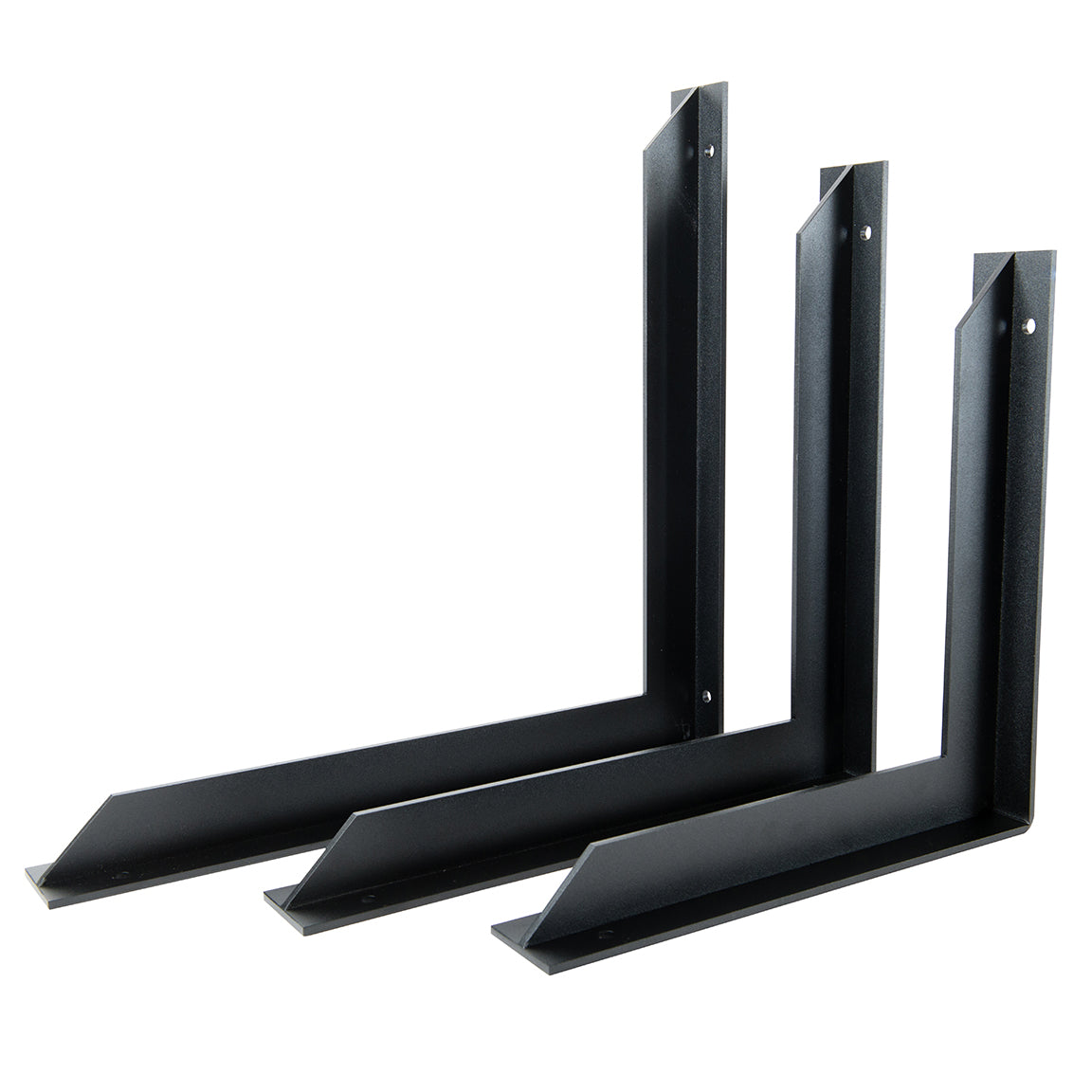L-Bracket

L-Bracket
Durability & Style
When it comes to construction, woodworking, or even simple DIY projects, the stability and durability of the structure you’re working on is paramount. One of the most common and versatile components used to ensure this stability is the L-bracket. Despite its simple design, the L-bracket is an essential tool that plays a crucial role in a wide range of applications, from securing shelves to reinforcing frames.
What is an L-Bracket?
An L-bracket, also known as an angle bracket or corner brace, is a simple metal bracket shaped like the letter "L." It consists of two arms that form a right angle, usually with pre-drilled holes to allow for the insertion of screws or bolts. These brackets can be made from various materials, including steel, aluminum, and plastic, depending on the application. Their primary function is to provide structural support and stability by reinforcing joints and corners.
L-brackets come in a variety of sizes and thicknesses, making them suitable for different types of projects. The size of the bracket you choose will depend on the size and weight of the objects or structures you are working with. For heavier loads, thicker and larger brackets made from stronger materials like steel are recommended. L-brackets can also come with different finishes, such as galvanized, powder-coated, or stainless steel, to offer protection against corrosion and enhance aesthetic appeal.
The Various Uses of L-Brackets
L-brackets are incredibly versatile and can be used in a wide array of applications across different industries and projects. Below are some of the most common uses of L-brackets:
Securing Shelves and Cabinets
One of the most common uses of L-brackets is in the installation of shelves and cabinets. Whether you’re putting up a new shelf in your living room or installing kitchen cabinets, L-brackets provide the necessary support to keep these structures securely attached to walls. By placing an L-bracket at the corner where the shelf meets the wall, you ensure that the shelf remains stable and can hold the weight of the items placed on it.
Reinforcing Furniture
Furniture, especially wooden furniture, can often become unstable over time due to wear and tear. L-brackets are frequently used to reinforce joints and corners in furniture, ensuring that tables, chairs, and other items remain sturdy. They can be particularly useful in DIY furniture projects where additional support is needed to maintain structural integrity.
Framing and Construction
In construction, L-brackets are often used to reinforce framing, especially in areas where two beams or studs meet at a corner. They provide extra support to the joint, preventing it from shifting or coming apart under stress. L-brackets are also used in building temporary structures, such as scaffolding, where stability is crucial.
Mounting Equipment
L-brackets are widely used in industrial and commercial settings to mount equipment securely. Whether it’s mounting a piece of heavy machinery to the floor or attaching electrical panels to a wall, L-brackets provide the necessary support to ensure that the equipment remains in place and functions correctly.
Art and Photography
L-brackets are also commonly used in the art and photography world. In photography, for instance, L-brackets are used to mount cameras to tripods, allowing for quick transitions between landscape and portrait orientations. Artists might use L-brackets to secure frames or canvases to walls or easels.
Home Improvement Projects
For the DIY enthusiast, L-brackets are indispensable. From building a custom bookshelf to creating a new garden trellis, L-brackets provide the necessary support to bring your vision to life. They are also useful for making quick repairs around the house, such as fixing a wobbly table leg or securing a loose fence post.
Why You Need L-Brackets
Given their versatility and the crucial role they play in providing structural support, there are several reasons why L-brackets are an essential component in many projects. Here are some key reasons why you should consider purchasing L-brackets for your next project:
Enhanced Structural Integrity
The primary function of an L-bracket is to reinforce and stabilize joints and corners. By adding an L-bracket to your project, you significantly enhance its structural integrity, making it more resistant to stress and wear. This is especially important in projects that involve heavy loads or frequent use, such as shelving, furniture, and construction.
Preventing Joint Failure
In many cases, the joints and corners of a structure are the most vulnerable points. Without proper reinforcement, these areas are prone to failure, which can lead to the entire structure collapsing. L-brackets help distribute the load more evenly across the joint, preventing it from failing and ensuring the longevity of your project.
Versatility in Applications
As mentioned earlier, L-brackets can be used in a wide range of applications, from home improvement projects to industrial construction. This versatility makes them a valuable addition to any toolbox. Whether you’re a professional contractor or a DIY enthusiast, having a variety of L-brackets on hand ensures that you’re prepared for any project.
Ease of Installation
One of the biggest advantages of L-brackets is their ease of installation. With just a few screws or bolts, you can quickly and securely attach an L-bracket to your project. This simplicity makes L-brackets an attractive option for both professionals and hobbyists alike. Even if you have minimal experience with tools, you can easily install an L-bracket to enhance the stability of your project.
Cost-Effective Solution
L-brackets are a cost-effective solution for providing additional support to your projects. Compared to other reinforcement options, such as welding or custom-made braces, L-brackets are relatively inexpensive and readily available. This makes them an economical choice for anyone looking to improve the stability and durability of their projects without breaking the bank.
Aesthetic Appeal
While functionality is the primary concern when choosing an L-bracket, many brackets are designed with aesthetics in mind. Brackets with decorative finishes, such as brushed stainless steel or powder-coated colors, can add a touch of elegance to your project. This is particularly important in applications where the bracket will be visible, such as in shelving or furniture.
Customization Options
L-brackets are available in various sizes, materials, and finishes, allowing you to choose the perfect bracket for your specific needs. Whether you need a heavy-duty bracket for a construction project or a small, decorative bracket for a home improvement task, there is an L-bracket available to meet your requirements.
Choosing the Right L-Bracket
With so many options available, choosing the right L-bracket for your project can seem overwhelming. However, by considering a few key factors, you can easily find the perfect bracket for your needs:
Material
The material of the L-bracket is one of the most important factors to consider. For most heavy-duty applications, steel is the preferred material due to its strength and durability. Stainless steel is especially popular for outdoor projects or areas with high moisture, as it offers excellent corrosion resistance. Aluminum is a good choice for lighter projects where weight is a concern, while plastic brackets can be used for decorative purposes or in situations where minimal load-bearing is required.
Size and Thickness
The size and thickness of the L-bracket should match the demands of your project. Larger, thicker brackets are better suited for heavy loads and larger structures, while smaller brackets can be used for lighter tasks. It’s important to ensure that the bracket you choose is capable of handling the weight and stress of your project.
Hole Placement and Size
Different L-brackets come with varying hole placements and sizes. The placement of the holes will determine how the bracket can be attached to your project, while the size of the holes will dictate the type of screws or bolts that can be used. Make sure the bracket you choose has holes that align with your project’s needs.
Finish
The finish of the L-bracket is an important consideration, especially if the bracket will be visible in the final product. A galvanized or powder-coated finish can provide additional protection against rust and corrosion, while a decorative finish can enhance the overall appearance of your project.
Common Mistakes to Avoid When Using L-Brackets
While L-brackets are relatively easy to use, there are some common mistakes that can undermine their effectiveness:
Using the Wrong Size Bracket
One of the most common mistakes is using an L-bracket that is too small or too large for the project. An undersized bracket may not provide sufficient support, while an oversized bracket can be unnecessarily bulky and difficult to work with. Always choose a bracket size that matches the scale of your project.
Incorrect Placement
Proper placement of the L-bracket is crucial for ensuring stability. Make sure the bracket is positioned in a way that evenly distributes the load across the joint or corner. Placing the bracket too close to the edge or in a position where it doesn’t fully engage with the material can reduce its effectiveness.
Using Inadequate Fasteners
The screws or bolts used to attach the L-bracket to your project are just as important as the bracket itself. Using fasteners that are too short, too long, or made from weak materials can compromise the stability of the bracket. Always choose high-quality fasteners that are appropriate for the material you’re working with.
Neglecting Aesthetic Considerations
In projects where the L-bracket will be visible, neglecting the aesthetic aspects of the bracket can detract from the overall appearance of your work. Consider choosing a bracket with a finish that complements the design of your project.
Ignoring Load Limits
Every L-bracket has a load limit, which is the maximum weight it can support without failing. Exceeding this limit can cause the bracket to bend or break, potentially leading to the collapse of your structure. Always ensure that the bracket you choose is rated for the load it will be supporting.
Why You Should Buy from Steel Design Solutions
L-brackets are an essential component in a wide variety of projects, offering crucial support and stability to structures both large and small. Whether you’re securing a shelf, reinforcing furniture, or constructing a new frame, the right L-bracket can make all the difference in ensuring the success and longevity of your project.
When it comes to choosing high-quality L-brackets, Steel Design Solutions stands out as a leader in the industry. With a commitment to excellence, Steel Design Solutions offers a wide range of L-brackets made from top-grade materials, ensuring durability and reliability in every product. Their brackets are designed to meet the needs of both professionals and DIY enthusiasts, providing the perfect balance of strength, versatility, and aesthetic appeal.
By choosing Steel Design Solutions, you can be confident that you’re investing in products that will stand the test of time. Whether you’re working on a small home improvement project or a large-scale construction endeavor, Steel Design Solutions has the L-brackets you need to get the job done right.
So, for your next project, don’t settle for anything less than the best. Choose L-brackets from Steel Design Solutions and experience the difference that quality craftsmanship can make.







